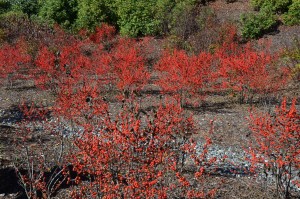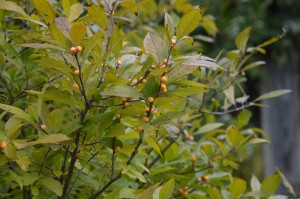To escape from dreary days this winter, brightened up your landscape with deciduous hollies. Among a long, long list of deciduous holly species, winterberry holly (Ilex verticillata) is the superior choice (USDA hardiness zones 3-9). Inconspicuous white blooms in spring are followed by red, orange, or yellow berries in fall. Compared to their evergreen kin, winterberry hollies shed all foliage in the fall, revealing the colorful berry fruits.
Winterberry holly is native to swampy areas in the eastern half of North America. Winterberries prefer full sun and a moist, acidic soil (at home in wet soil). Well established after two years, shrubs are drought tolerant; berry production is highest on swampy or boggy ground. Feed with granular 10-10-10 or equivalent or with Holly-tone® in late winter or early spring.
In spring bees pollinate the tiny holly flowers, and birds consume the vibrant fruits in winter. Cut berry-filled branches in fall and bring indoors to decorate. In early spring prune deciduous hollies partially and back to the ground every 4-5 years. Disease and insect problems are rare and deer leave hollies alone.
Deciduous hollies are excellent for massing, for hedging, for wet soils, and for attracting wildlife to your landscape. Plant one “matched” male selection nearby 8-10 female plants to boost fruit numbers. Mature plant size depends on cultivar planted. Some of the better selections of deciduous hollies include:
Berry Heavy® – 6 to 8 feet tall shrub and abundant bright red berries.
Berry Nice® – 6-8 feet tall shrub and bright red berries.
‘Bonfire’ (I. verticillata x serrata) – 8 by 8 feet holly and bears small red berries at young age.
‘Red Sprite’ – compact 3 to 5 feet tall with large, bright red berries and lustrous dark green leaves.
‘Sparkleberry’ (I. verticillata x serrata) –upright branched, 12 feet tall, and brilliant red fruit.
‘Winter Gold’ – matures to 7 by 7 feet with lovely salmon colored berries.
Winter Red® – matures to 8 by 8 feet with lustrous dark green leaves and bright red berries.
Male Pollinators:
‘Apollo’ ( I. verticillata x serrata) – pollinator for ‘Bonfire’, ‘Red Sprite’, and ‘Sparkleberry’.
‘Jim Dandy’ – pollinator for Berry Heavy®, Berry Nice®, ‘Red Sprite’.
‘Southern Gentleman’ – pollinator for Berry Nice®, ‘Sparkleberry’, ‘Winter Gold’, Winter Red®.



 Posted in
Posted in 
